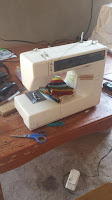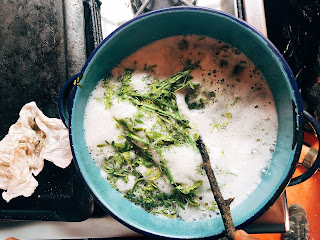Last week during Semana Santa (Holy Week), Chuck, Kate, Katie, Kelly, Lance, and Selina lived in the rug-weaving pueblo called Teotitlán del Valle. We split up and lived with four different families involved in the Vida Nueva cooperative. This is an all women's co-op who weave beautiful rugs of all shapes and styles with naturally dyed wool (which they dye themselves). However, these women are not just weavers, but protectors of their land and community. They do projects within the community to connect the pueblo together and raise awareness on keeping their land healthy. Our group was able to help out with a project of theirs.
 Hey it’s Kelly, I’m going to talk about the project that we worked on with Vida Nueva. After we arrived in Teotitlán and were assigned our host families, the women went straight to business. They told us that on the following day, Tuesday, we were to meet at Vida Nueva to start planning out the execution of our project. She told us that she wanted to bring awareness to making sure people keep the land clean by having us install trash bins in the community. So, the following day we gathered together and each family was given two signs and a dirty tin bucket. We were instructed that on Wednesday we were to wash the signs and the trash can and then repaint them, as well as attaching a post to the sign, so then on Thursday we can meet up and distribute the signs and bins. My experience with prepping the materials was a lot of fun. Chuck and Katie came to our home and with the help of the 10-year-old girl and her 4-year-old twin siblings we washed and painted the materials. Some of us got completely soaked while trying to wash the signs with a hose, and then all of us were covered in paint because there was only one paint brush, so finger painting was definitely the way to go. Finally, everyone woke up early on Thursday and met at 6:45 at a newly planted tree sanctuary where we were able to successfully install two of the eight signs. We then needed help from one of the woman's nephews because we struggled with getting the posts into the ground and making sure that the posts stopped falling apart. We also hung up the trash bins so that people wouldn’t litter in the sanctuary.
Hey it’s Kelly, I’m going to talk about the project that we worked on with Vida Nueva. After we arrived in Teotitlán and were assigned our host families, the women went straight to business. They told us that on the following day, Tuesday, we were to meet at Vida Nueva to start planning out the execution of our project. She told us that she wanted to bring awareness to making sure people keep the land clean by having us install trash bins in the community. So, the following day we gathered together and each family was given two signs and a dirty tin bucket. We were instructed that on Wednesday we were to wash the signs and the trash can and then repaint them, as well as attaching a post to the sign, so then on Thursday we can meet up and distribute the signs and bins. My experience with prepping the materials was a lot of fun. Chuck and Katie came to our home and with the help of the 10-year-old girl and her 4-year-old twin siblings we washed and painted the materials. Some of us got completely soaked while trying to wash the signs with a hose, and then all of us were covered in paint because there was only one paint brush, so finger painting was definitely the way to go. Finally, everyone woke up early on Thursday and met at 6:45 at a newly planted tree sanctuary where we were able to successfully install two of the eight signs. We then needed help from one of the woman's nephews because we struggled with getting the posts into the ground and making sure that the posts stopped falling apart. We also hung up the trash bins so that people wouldn’t litter in the sanctuary.

Hi this is Kate! Something that I found very shocking was the state of nutrition in the pueblo. There was a vast contrast between cooking healthy soups and fresh tortillas daily and also guzzling liters of soda and not wanting to walk anywhere (at least this is my experience). My assumption is that the latter are signs of status and luxury, so my host family felt compelled to offer those luxuries to me because I am a guest from a more wealthy background. I also noticed that many times soda was cheaper than water, which just goes to show how corporations target populations such as these to make money. I did not see a single person drinking just straight water; everything was some sort of sweetened beverage. The food we ate was very nutritious, with no meat and lots of vegetables and fresh cheeses. I was surprised at the amount of sugar in EVERYTHING. Our coffee was served to us in the morning pre sweetened, with so much sugar it made your mouth pucker. The two four year olds living in my house came and sat with us and even had a huge bowl of coffee every morning! Overall, a very different experience than back in the U.S, at least in Vermont!
 Speaking of food, market dynamics were extremely interesting. Every day I went with my host mom into the market to help her sell tortillas. I noticed she bought cheese, beans, and vegetables from the same people every day, and asked her why. She stated that it was because she knew him or her; they were all some sort of family member. Living in a small pueblo, many of these people know or are related to a lot of the sellers in these markets, which makes the market more of a community meeting place and a social hub. It also ensures that all the vendors selling the same things get consistent business.
Speaking of food, market dynamics were extremely interesting. Every day I went with my host mom into the market to help her sell tortillas. I noticed she bought cheese, beans, and vegetables from the same people every day, and asked her why. She stated that it was because she knew him or her; they were all some sort of family member. Living in a small pueblo, many of these people know or are related to a lot of the sellers in these markets, which makes the market more of a community meeting place and a social hub. It also ensures that all the vendors selling the same things get consistent business.
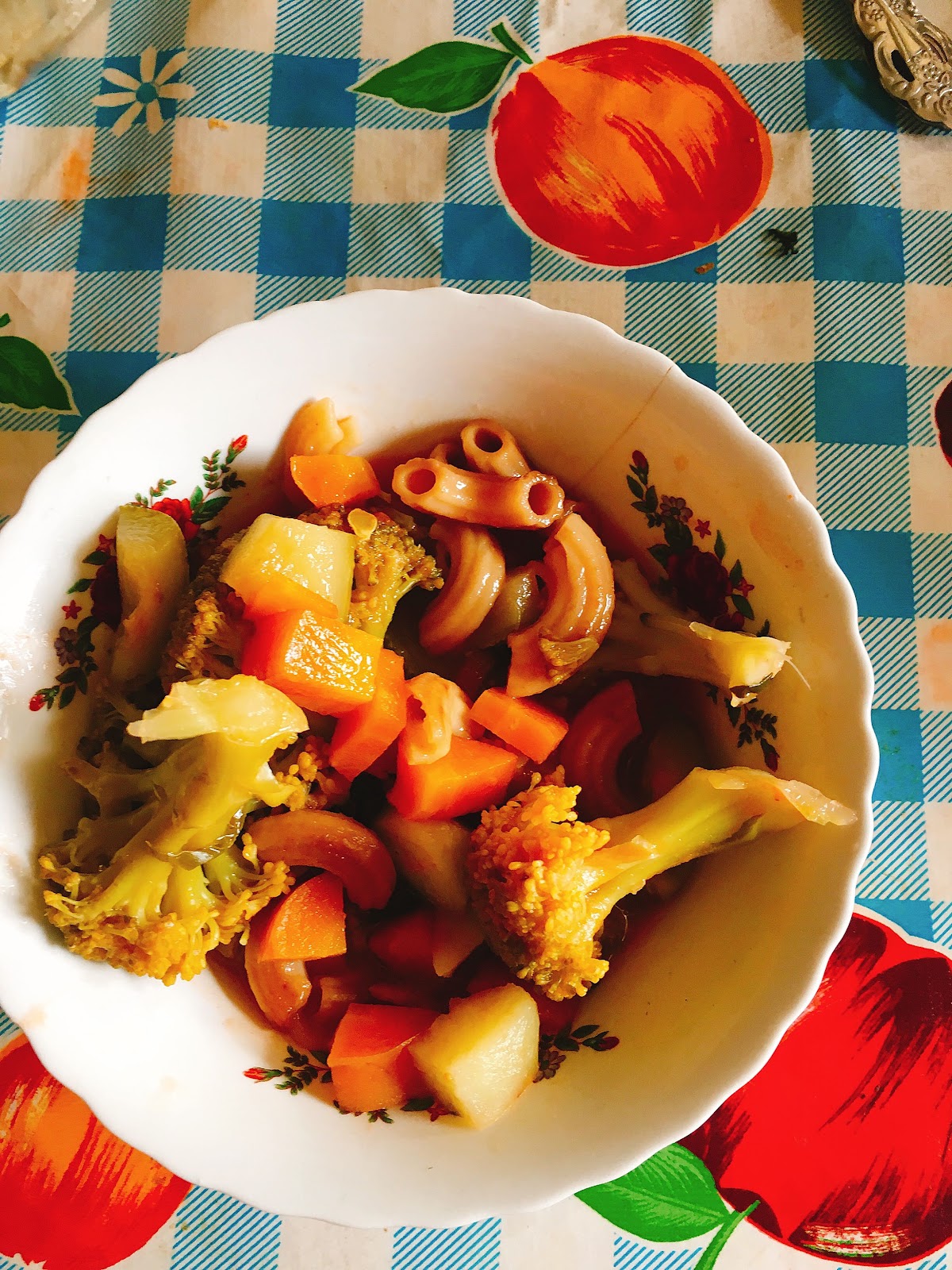 Hola reader, my name is Katie and this is what I gained from the village stay experience through family life and everyday activity. I was excited because Vida Nueva was my first choice and I was looking forward to living with women who I find so empowering. Chuck and I were paired to live together with Patrona, a middle-aged blind woman who lives with her eighteen year old son and husband Juan. I was a little intimidated at first living with a blind woman but I also gained knowledge about what it means to live with someone with that disability. It also really forced me to practice my Spanish because I could not clarify what I was saying through actions. It was incredibly humbling and I learned about yet another thing I have taken for granted. I am so appreciative for Patrona’s kindness and I love how her and Juan really opened up their home to Chuck and I.
Hola reader, my name is Katie and this is what I gained from the village stay experience through family life and everyday activity. I was excited because Vida Nueva was my first choice and I was looking forward to living with women who I find so empowering. Chuck and I were paired to live together with Patrona, a middle-aged blind woman who lives with her eighteen year old son and husband Juan. I was a little intimidated at first living with a blind woman but I also gained knowledge about what it means to live with someone with that disability. It also really forced me to practice my Spanish because I could not clarify what I was saying through actions. It was incredibly humbling and I learned about yet another thing I have taken for granted. I am so appreciative for Patrona’s kindness and I love how her and Juan really opened up their home to Chuck and I.
One of my favorite experiences was cooking with Juan and Patrona. Patrona was very adamant about teaching us how to make this vegetable soup. She was so excited for us to learn about a daily aspect of her life. I feel that food and cooking really is a great aspect of someone’s culture and a form of expression. The creation of the soup turned into a group activity that took most of the afternoon. We took our time cutting the vegetables and pureeing the ingredients. Juan and Patrona were more than happy to include Chuck and me in most of the work even in circumstances where we didn’t know what we were doing (which was most of the time). It is interesting to compare the way we cook in the United States to this one instance that I experienced in a village. Back home, I feel that the day to day cooking can be very individualized and we are all about getting it done fast. This took a whole afternoon. I tried to take in all the ingredients by smelling them and noting everything that went into the soup. The soup consisted of tomatoes, broccoli, garlic, carrots, zucchini, and pasta.
Hi it's Chuck! During my stay in Teotitlán I found it very interesting to watch the social interactions between my host family and the town. I was particularly interested in the difference between their way of shaking hands and what I have seen in Oaxaca and the U.S. Their handshake (or at least those involving a woman) involves using two hands and bowing one’s head slightly. I thought this was interesting just because it made the interaction seem more genuine and sincere. I also saw this sincerity when I was walking with my host family and they greeted a man and his son who were riding their bikes. Instead of just saying hello back, the man and son dismounted from their bikes to shake hands with my host parents. I thought this was worth noting because perhaps it says something about their sense of community as well as pace of life. I think that in the U.S. this would be way more unusual. I feel that the pace of life in Mexico is much slower and more community orientated, and in many U.S. and European countries people are much more concerned with getting all their errands done and accomplishing tangible goals rather than fostering a strong sense of community.
Overall my week in Teotitlán was really quite fun and relaxing. I think a lot of us had a lot of trouble adjusting to village life-bucket showers, lack of our idea of stimulation, etc- but I really do think the village stay was mind opening for me, as cliché as that sounds. I think that it is really easy to forget that just because people’s lives seem so strikingly different at first glance, that isn’t always the case and I think living with my host family for a few days reminded me that wherever you go, people are people, with similar games, humor, and emotions as I do.
 Hello reader, my name is Lance and during the Vida Nueva trip in Teotitlán I was placed in a family on my own and had an experience a little different than that of the others. Although my living conditions were more "rustic" than my UVM counterparts, it was actually somewhat enjoyable. I almost felt as if I were camping- even though I had the luxury of my own building, I felt quite exposed to the elements. Luckily I am used to camping with little resources available so I was fine with it. My family was very kind and worked on their respective rugs throughout the day. Because my family was always hard at work, it didn’t give me much to do, but it gave me the opportunity to observe a lot. I occasionally just walked around the town, seeing what there was to see, with the occasional “buenos/as dias/tardes/noches” to passerbyers. I did attend a couple of the processions, but I wasn't raised in a religious manner, so I wasn’t so sure what was going on, much less what to do, but it was interesting nonetheless. On the final day, me and Miguel (a fellow companion from the Bii Dau company) woke up bright and early at 5:30 AM to go on a little hike up the tallest mountain in the area. It was an arduous uphill battle, but was worth the view. On our way back down we saw some really interesting animals and flora, not to mention a marked cave. After that we made our way back to the city. I’m not sure what I’d take back from this trip. I’ve been and stayed in a lot of extremely impoverished areas so I somewhat knew what to expect from this experience, though I will admit mine specifically took me by surprise. One thing is for sure, and that is that I am more aware of how the kind natured towns people go about their daily lives here in the good ol’ state of Oaxaca.
Hello reader, my name is Lance and during the Vida Nueva trip in Teotitlán I was placed in a family on my own and had an experience a little different than that of the others. Although my living conditions were more "rustic" than my UVM counterparts, it was actually somewhat enjoyable. I almost felt as if I were camping- even though I had the luxury of my own building, I felt quite exposed to the elements. Luckily I am used to camping with little resources available so I was fine with it. My family was very kind and worked on their respective rugs throughout the day. Because my family was always hard at work, it didn’t give me much to do, but it gave me the opportunity to observe a lot. I occasionally just walked around the town, seeing what there was to see, with the occasional “buenos/as dias/tardes/noches” to passerbyers. I did attend a couple of the processions, but I wasn't raised in a religious manner, so I wasn’t so sure what was going on, much less what to do, but it was interesting nonetheless. On the final day, me and Miguel (a fellow companion from the Bii Dau company) woke up bright and early at 5:30 AM to go on a little hike up the tallest mountain in the area. It was an arduous uphill battle, but was worth the view. On our way back down we saw some really interesting animals and flora, not to mention a marked cave. After that we made our way back to the city. I’m not sure what I’d take back from this trip. I’ve been and stayed in a lot of extremely impoverished areas so I somewhat knew what to expect from this experience, though I will admit mine specifically took me by surprise. One thing is for sure, and that is that I am more aware of how the kind natured towns people go about their daily lives here in the good ol’ state of Oaxaca.
Selina here, focusing on religion. The pueblo of Teotitlán is very Catholic-- interesting due to the fact that a large portion of the population is indigenous and Zapotec. During Semana Santa, people were on vacation and a lot of effort was put into preparing the town for the resurrection of Jesus Christ on Sunday (Easter). Monday started off with a procession in which nearly the entire pueblo partook. It consisted of carrying around religious figures, such as the Virgin Mary, and the parade would occasionally stop so that people could worship the Virgin and bring food and flowers. During these stops, food and drink were offered to everyone.
On Thursday night, I went with my host mother, her sister, and their mother to church at midnight. There was an altar set up with fluorescent christmas lights and lots of candles, and incense was being burned constantly. People came in and out of the church all night with copious amounts of flowers, to come kneel in front of the altar and pray, and rosaries were being said out loud. Around 1am, 12 men dressed as the apostles came in and sat down in front of the altar, and played music and sang songs. Food and drinks were being offered to those coming to worship. My host grandmother and myself went home around 1:30, but my host mother and her sister stayed until six in the morning.
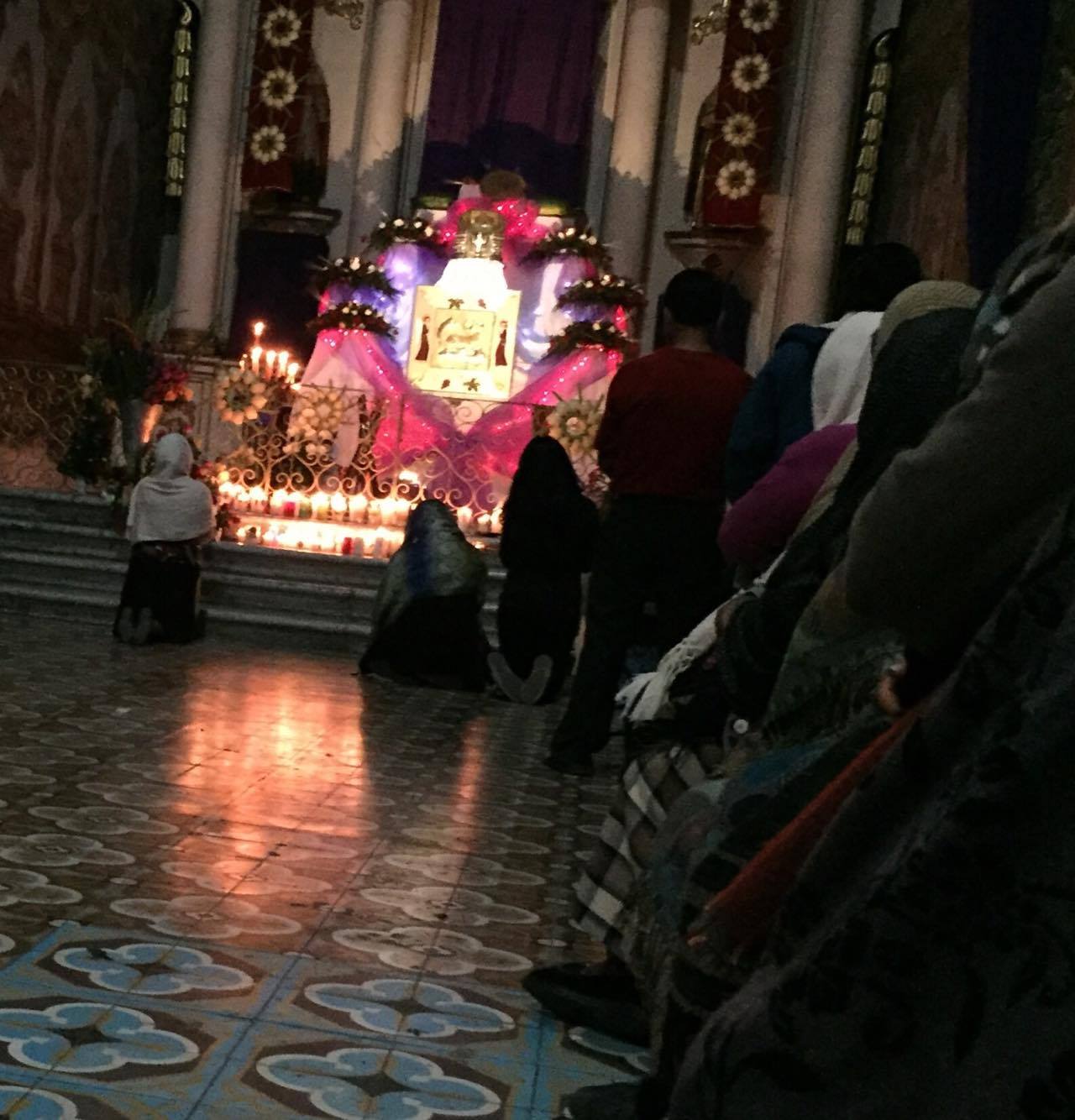 Friday was another procession day. I woke up to my host family cleaning the street outside their house, because the procession would be walking through there. This consisted of sweeping the street, throwing water on it, and then laying out flowers and flower petals. The procession then came (with loud brass music) and walked by the house carrying a statue of Jesus. This procession then met with another procession coming from the other side of town, holding a statue of the Virgin Mary. Jesus and Mary met in the town center, and a priest said a few words in front of all the townspeople who were gathered around.
Friday was another procession day. I woke up to my host family cleaning the street outside their house, because the procession would be walking through there. This consisted of sweeping the street, throwing water on it, and then laying out flowers and flower petals. The procession then came (with loud brass music) and walked by the house carrying a statue of Jesus. This procession then met with another procession coming from the other side of town, holding a statue of the Virgin Mary. Jesus and Mary met in the town center, and a priest said a few words in front of all the townspeople who were gathered around.
Later in the afternoon, we went back to the church to witness Jesus being taken down from the cross. This was done with extreme care, and took about half an hour. He was then put in a casket and the casket was once again carried through the town, to the cemetery and back to the church, as another procession. This procession went around the town twice, and by the time they got back to the church it was dark out.
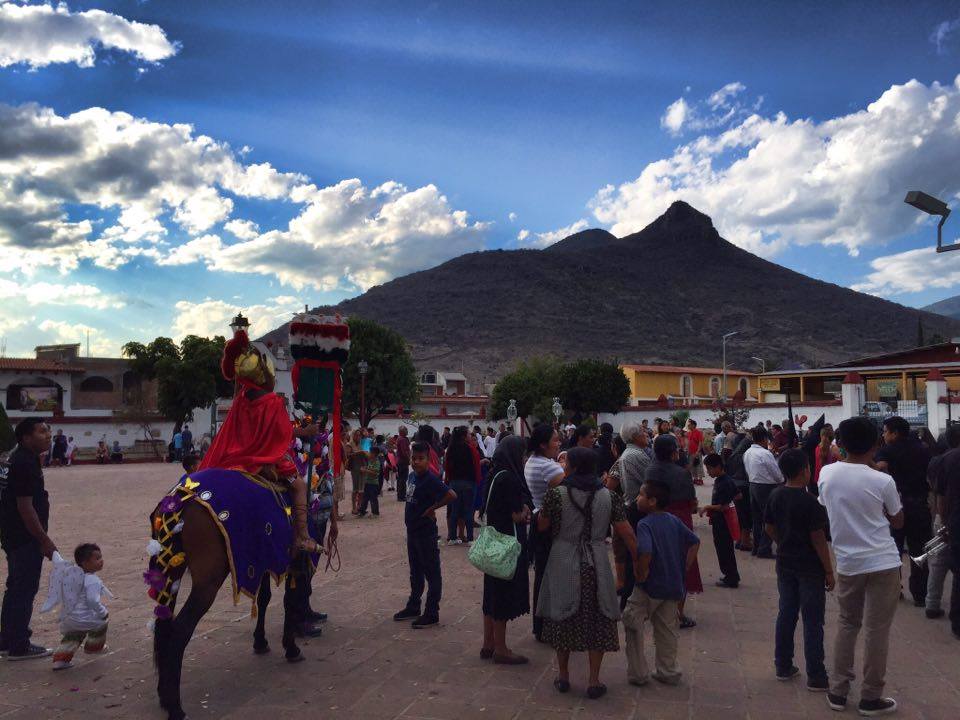 It was extremely interesting to experience such intense worship. I am Catholic but have never seen people go to such lengths to pay their tributes. In America we don’t have such processions, and “Semana Santa” doesn’t really exist in the way that it does down here. People make the sign of the cross just passing by the church, and the church area was a communal place to hang out-- more so than the town center. I truly enjoyed my stay in Teotitlan, and feel very lucky and grateful that we got to spend it there during such a sacred time.
It was extremely interesting to experience such intense worship. I am Catholic but have never seen people go to such lengths to pay their tributes. In America we don’t have such processions, and “Semana Santa” doesn’t really exist in the way that it does down here. People make the sign of the cross just passing by the church, and the church area was a communal place to hang out-- more so than the town center. I truly enjoyed my stay in Teotitlan, and feel very lucky and grateful that we got to spend it there during such a sacred time.





